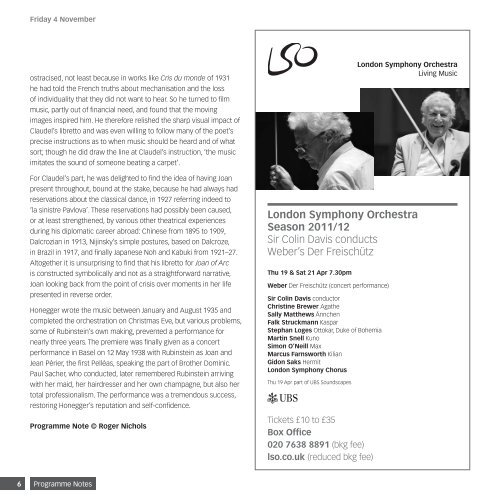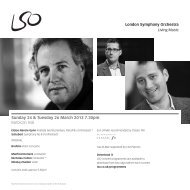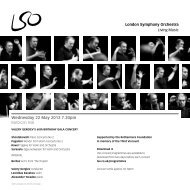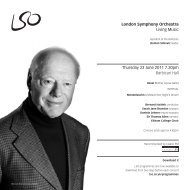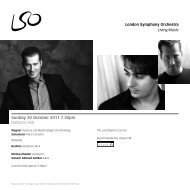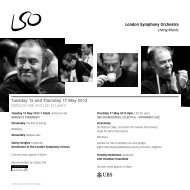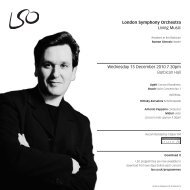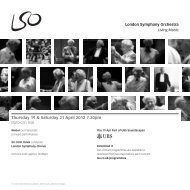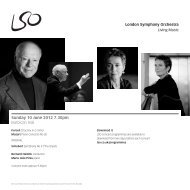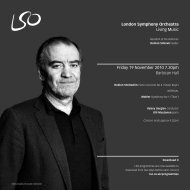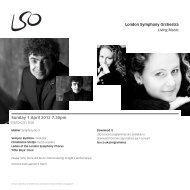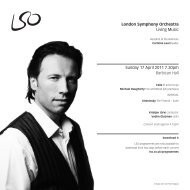6 November programme PDF - London Symphony Orchestra
6 November programme PDF - London Symphony Orchestra
6 November programme PDF - London Symphony Orchestra
You also want an ePaper? Increase the reach of your titles
YUMPU automatically turns print PDFs into web optimized ePapers that Google loves.
Friday 4 <strong>November</strong><br />
ostracised, not least because in works like Cris du monde of 1931<br />
he had told the French truths about mechanisation and the loss<br />
of individuality that they did not want to hear. So he turned to film<br />
music, partly out of financial need, and found that the moving<br />
images inspired him. He therefore relished the sharp visual impact of<br />
Claudel’s libretto and was even willing to follow many of the poet’s<br />
precise instructions as to when music should be heard and of what<br />
sort; though he did draw the line at Claudel’s instruction, ‘the music<br />
imitates the sound of someone beating a carpet’.<br />
For Claudel’s part, he was delighted to find the idea of having Joan<br />
present throughout, bound at the stake, because he had always had<br />
reservations about the classical dance, in 1927 referring indeed to<br />
‘la sinistre Pavlova’. These reservations had possibly been caused,<br />
or at least strengthened, by various other theatrical experiences<br />
during his diplomatic career abroad: Chinese from 1895 to 1909,<br />
Dalcrozian in 1913, Nijinsky’s simple postures, based on Dalcroze,<br />
in Brazil in 1917, and finally Japanese Noh and Kabuki from 1921–27.<br />
Altogether it is unsurprising to find that his libretto for Joan of Arc<br />
is constructed symbolically and not as a straightforward narrative,<br />
Joan looking back from the point of crisis over moments in her life<br />
presented in reverse order.<br />
Honegger wrote the music between January and August 1935 and<br />
completed the orchestration on Christmas Eve, but various problems,<br />
some of Rubinstein’s own making, prevented a performance for<br />
nearly three years. The premiere was finally given as a concert<br />
performance in Basel on 12 May 1938 with Rubinstein as Joan and<br />
Jean Périer, the first Pelléas, speaking the part of Brother Dominic.<br />
Paul Sacher, who conducted, later remembered Rubinstein arriving<br />
with her maid, her hairdresser and her own champagne, but also her<br />
total professionalism. The performance was a tremendous success,<br />
restoring Honegger’s reputation and self-confidence.<br />
Programme Note © Roger Nichols<br />
6 Programme Notes<br />
Tickets £10 to £35<br />
Box Office<br />
020 7638 8891 (bkg fee)<br />
lso.co.uk (reduced bkg fee)<br />
<strong>London</strong> <strong>Symphony</strong> <strong>Orchestra</strong><br />
Living Music<br />
<strong>London</strong> <strong>Symphony</strong> <strong>Orchestra</strong><br />
Season 2011/12<br />
Sir Colin Davis conducts<br />
Weber’s Der Freischütz<br />
Thu 19 & Sat 21 Apr 7.30pm<br />
Weber Der Freischütz (concert performance)<br />
Sir Colin Davis conductor<br />
Christine Brewer Agathe<br />
Sally Matthews Ännchen<br />
Falk Struckmann Kaspar<br />
Stephan Loges Ottokar, Duke of Bohemia<br />
Martin Snell Kuno<br />
Simon O’Neill Max<br />
Marcus Farnsworth Kilian<br />
Gidon Saks Hermit<br />
<strong>London</strong> <strong>Symphony</strong> Chorus<br />
Thu 19 Apr part of UBS Soundscapes


